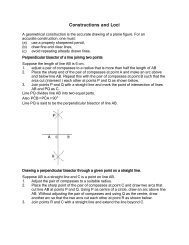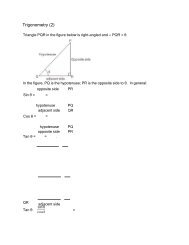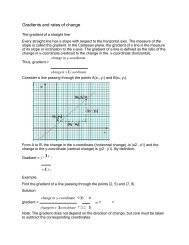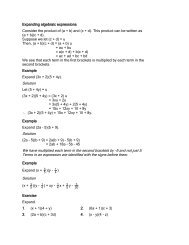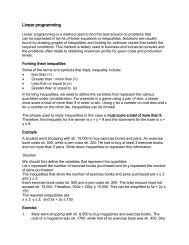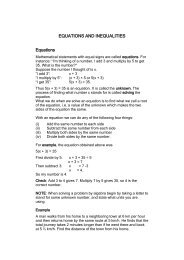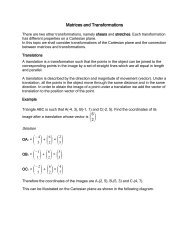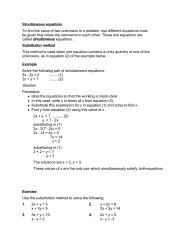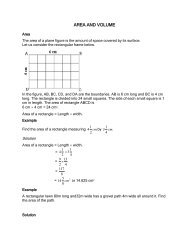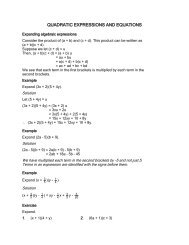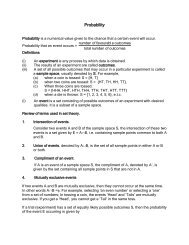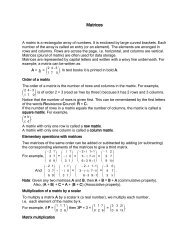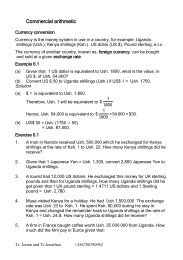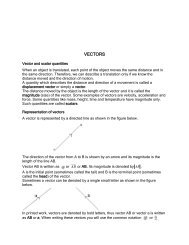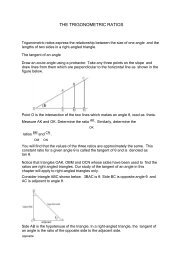J4
You also want an ePaper? Increase the reach of your titles
YUMPU automatically turns print PDFs into web optimized ePapers that Google loves.
APPROXIMATIONS<br />
Rounding off<br />
Examples<br />
1. A boy counted 3641 beans in a bag. (read the number as: Three thousand, six<br />
hundred and forty one)<br />
How many is that to the nearest hundred?<br />
3641 is closer to 3600 than to 3700. So it is 3600 to the nearest hundred.<br />
How many is that to the nearest thousand?<br />
3641 is closer to 4000 than to 3000. So it is 4000 to the nearest thousand<br />
2. A girl scored 95.7% in the math test.<br />
What is her score to the nearest whole percentage?<br />
95.7 is closer to 96 than to 95. So it is 96% to the nearest<br />
percent.<br />
What is her score to the nearest ten percent?<br />
95.7 is closer to 100 than to 90. So it is 100% to the nearest ten<br />
percent.<br />
Exercise<br />
1. Write these quantities to the nearest hundred.<br />
(a) 346 kg (b) 780 m (c) 152 mm (d) 61 cm<br />
(e) 932 litres (f) 967 litres (g) 5412 g (h) 9650 kg.<br />
2. Write these quantities to the nearest whole number.<br />
(a) 5.2% (b) 7.6 m (c) 9.8 mm (d) 5.36<br />
(e) 25.7 g (f) 90.13 kg (g) 146.713 m (h) 389.92 cm<br />
3. The area of Gulu district is 11,560 square kilometers. What is that to the nearest<br />
thousand?<br />
4. In Arua district the animal population in 1992 was as follows:<br />
Cattle: 100,746 Goats: 188,798 Sheep: 38,651<br />
(a) Write each of these to the nearest thousand.<br />
(b) Add up the total population and write that to the nearest thousand.
Decimal places<br />
A number may have many decimal places as possible. The number of decimal places a<br />
number has is counted from a digit immediately after the decimal point toward the right.<br />
For example, 4.2341706 has 7 decimal places; 0.10051 has five decimal places.<br />
If rounding to wanted number of decimal places, you check the digit in the next decimal<br />
place. If this digit is less than five, the last digit in the require decimal places remains<br />
unchanged but if it is 5 up to 9, the last digit in the decimal places increases by 1.<br />
Examples<br />
1. Write 5.762 to 2 decimal places<br />
1.762 becomes 5.76<br />
The answer is 5.76 (to 2 dp).<br />
It is helpful to write dp instead of ‘decimal places’<br />
2. Write 354.392 to 2 decimal places<br />
The answer is 354.40 (to 2 dp)<br />
3. Write 56.9097 to 3 decimal places<br />
The answer is 56.910 (to 3 dp)<br />
Exercise<br />
1. Write the following quantities to 1 dp<br />
(a) 5.76<br />
(b) 12.34<br />
(c) 8.473<br />
(d) 14.96<br />
2. Write the following quantities to 2 dp.<br />
(a) 3.926<br />
(b) 52.3921<br />
(c) 4.696<br />
(d) 21.9951<br />
3. Write 36.1986345 to:<br />
(a) 3 dp<br />
(b) 6 dp<br />
4. Write 5.3890962 to<br />
(a) 2 dp<br />
(b) 5 dp.<br />
5. 1 mile = 1.609 kilometres. Write 5 miles in kilometers correct to<br />
2 dp.
Significant figures (sf)<br />
Significant figures (also called significant digits) of a number are those digits that carry<br />
meaning contributing to its accuracy.<br />
Rules for counting significant figures are summarized below:<br />
1. All non-zero digits are considered significant. E.g 123.45 has five significant figures:<br />
1, 2, 3, 4, 5.<br />
2. Zeros appearing anywhere between two non-zero digits are significant. E.g. 101.12<br />
has five significant figures: 1, 0, 1, 1, and 2.<br />
3. Leading zeros are not significant. For example, 0.00012 has two significant figures: 1<br />
and 2.<br />
4. Trailing zeros in a number containing a decimal point are significant. For example,<br />
12.2300 has six significant figures: 1, 2, 2, 3, 0 and 0. The number 0.00122300 still<br />
has only six significant figures (the zeros before the 1 are not significant). In addition,<br />
120.00 has five significant figures.<br />
5. Trailing zeros in a number not containing a decimal point are not significant. For<br />
example 470,000 has two significant figures.<br />
Examples<br />
Rounding to 2 s.f:<br />
1. 12300 becomes 12000<br />
2. 13 stays as 13.<br />
3. 0.00123 becomes 0.0012<br />
4. 0.1 becomes 0.10, the trailing zero indicates that we are rounding to 2 s.f<br />
5. 0.0125 becomes 0.013<br />
6. 19800 becomes 20000.
Exercise<br />
1. Write 3426 to 3 significant figure.<br />
2. Write 5294379 to 4 significant figure.<br />
3. Write 398.123 to 2 significant figures.<br />
4. Round off the following numbers correct to: (i) 2 SF, (ii) 3 SF, (iii) 4 SF<br />
(a) 39.6582, (b) 2.61925<br />
(c) 304.9258 (d) 5.7984,<br />
(e) 0.0025498 (f) 76839<br />
(g) 81.9814, (h) 526.789<br />
(i) 3000.8<br />
COMMERCIAL ARITHMETICS<br />
Currency conversion<br />
Currency is the money system in use in a country, for example, Uganda<br />
shillings (Ush.), Kenya shillings (Ksh.), US dollar (US $), Pound sterling, e.t.c.<br />
The currency of another country, known as, foreign currency, can be bought<br />
and sold at a given exchange rate<br />
Example<br />
(a) Given that 1 US dollar is equivalent to Ush. 1800, what is the value, in US $, of<br />
Ush. 54,000?<br />
(b) Convert US $ 50 to Uganda shillings (Ush.) if US$ 1 = Ush. 1750.<br />
Solution<br />
(a) $ 1 is equivalent to Ush. 1,800.<br />
1<br />
Therefore, Ush. 1 will be equivalent to $<br />
1,800<br />
1<br />
Hence, Ush. 54,000 is equivalent to $ ×54,000 = $30.<br />
1,800<br />
(b) US$ 50 = Ush. (1750 50)<br />
= Ush. 87,500.
Exercise<br />
1. A man in Nairobi received Ush, 500,000 which he exchanged for Kenya shillings at<br />
the rate of Ksh. 1 to Ush. 22. How many Kenya shillings did he receive?<br />
2. Given that 1 Japanese Yen = Ush. 1,300, convert 2,800 Japanese Yen to Uganda<br />
shillings.<br />
3. A tourist had 12,000 US dollars. He exchanged this money for UK sterling pounds<br />
and then for Uganda shillings. How many Uganda shillings did he get given that 1<br />
UK pound sterling = 1.4711 US dollars and 1 Sterling pound = Ush. 2,780.<br />
4. Musa visited Kenya for a holiday. He had Ush.1,500,000 The exchange rate was<br />
Ush. 23 to Ksh. 1. He spent Ksh, 60,000 during his stay in Kenya and changed<br />
the remainder back to Uganda shillings at the rate of Ksh. 1 = Ush. 24.8. How<br />
many Uganda shillings did he receive?<br />
5. A firm in France bought coffee worth Ush. 35 000 000 from Uganda. How much<br />
did the firm pay in Euros given that:<br />
1 Euro = 0.9461 US dollars and 1 US dollar = Ush. 1 950.<br />
6. A Ugandan bought a car from Japan for Ush. 6 000 000. How much did he pay for<br />
the car in Japanese Yen if 1 Japanese Yen = 1.13 US dollars and 1 US dollar =<br />
Ush. 1 720.<br />
7. A Forex Bureau buys one US dollar at Ush.1,900 and sells one Pound Sterling at<br />
Ush.3,450. Atim wants to exchange 3,000 US dollars to pound sterling. How many<br />
pounds sterling will she get?<br />
Profit and Loss<br />
Cost price is the price at which goods are bought. It is also called the buying<br />
price or purchase price. Selling price is the price at which goods are sold by the<br />
second seller (retailer).<br />
If the selling price is more than the cost price, we say that a profit has been<br />
made. Thus, profit = selling price – cost price.<br />
Sometimes the cost price is more than the selling price. We call the difference<br />
between the two a loss. Thus, loss = cost price – selling price.<br />
Percentage profit and loss<br />
It is common to express the profit or loss as a percentage. Usually the<br />
percentage profit or loss is calculated as a percentage of the cost price. Thus,<br />
profit<br />
percentage profit = ×100 % and,<br />
cos t price
Example<br />
loss<br />
percentage loss = ×100 %.<br />
cos t price<br />
A trader buys goods for sh. 300 000 and sells them for sh. 360 000. Calculate<br />
the percentage profit.<br />
Solution<br />
Cost price = sh. 300 000<br />
Selling price = sh. 360 000<br />
Profit = sh. 360 000 – sh. 300 000<br />
= sh. 60 000<br />
60000<br />
Percentage profit = ×100%<br />
300000<br />
= 20%.<br />
Example<br />
A shopkeeper sells a dress for sh. 23 000 thereby making a profit of 15%.<br />
Calculate the cost price of the dress.<br />
Solution<br />
Selling price = sh. 23 000<br />
This is 115% of the cost price which is 100%<br />
100<br />
Therefore, cost price = × 23000 = sh. 20 000.<br />
115<br />
Alternatively, let the cost price be sh. X<br />
Selling price = sh. 23 000<br />
Percentage profit = 15%<br />
23000 x<br />
= 100<br />
%<br />
x<br />
23000 x<br />
Therefore, 100<br />
= 15<br />
x<br />
2 300 000 – 100x = 15x<br />
2 300 000 = 115x<br />
2300000<br />
x = = 20 000<br />
115<br />
Therefore, cost price = sh. 20 000.<br />
Exercise<br />
1. A man bought a bicycle at sh. 58 000. He sold it at a profit of 10%. What was his<br />
selling price?<br />
2. A dealer buys an item for sh. 8 000. He wishes to make a profit of 35%. What<br />
should the selling price be?
3. A radio that cost sh. 15 000 was sold at a loss of 18%. What was the selling price?<br />
4. A shopkeeper sells a bag for sh. 32 000, making a loss of 20%. What is the cost<br />
price?<br />
5. By selling a table for sh. 31 500, a shopkeeper makes a profit of 15%. Calculate<br />
the actual profit.<br />
6. An agent buys 200 items at a total cost of sh. 600 000. She sells 150 of them at a<br />
profit of 25% and the remainder at a loss of 8%. Find the amount of her net profit<br />
and express it as a percentage of the initial cost of all the items.<br />
7. A retailer buys 30 boxes of strawberries at sh. 3000 each and sells 27 boxes at<br />
30% profit. How much profit does he make?<br />
8. At a sale, the marked prices were reduced by 10%.<br />
(a) How much would a buyer have to pay for a shirt marked sh. 25 000?<br />
(b) If a customer pays sh. 48 000 for a dress. What is the marked price?<br />
Discount<br />
Sometimes a business reduces a small fraction of the selling price if the<br />
customer either pays cash or buys a lot of goods. This reduction is called<br />
discount. Most of the time, discounts are expressed as a percentage of the<br />
original price.<br />
Example<br />
A television set is selling at sh. 150 000. A customer is offered 4% discount for<br />
paying cash. How much does the customer pay for the TV?<br />
Solution<br />
Discount = 4% of sh. 150 000<br />
= sh. 6 000.<br />
The customer pays sh. 150 000 – sh. 6 000 = sh. 144 000<br />
Commission<br />
Sometimes firms use agents who are not actually their employees to sell their goods.<br />
The agent is usually paid a commission for selling the goods. Commission is normally<br />
given as a percentage of the sales made.<br />
Example<br />
A saleslady sold goods worth sh. 750 000. She was paid 2% commission on the sales.<br />
How much commission did she get?<br />
Value of goods sold = sh. 750 000
2<br />
Commission paid is = ×750 000<br />
100<br />
= sh. 15 000<br />
Interest<br />
Simple interest<br />
If you borrow money from a bank or other financial institution then you will have to pay<br />
interest (the charge paid for borrowing) in addition to your repayments.<br />
The money borrowed or lent is called the principal. When interest is paid at fixed<br />
intervals, yearly, half-yearly, quarterly or monthly, the principal is said to be lent (or<br />
borrowed) at simple interest.<br />
The interest is calculated on the original principal only. The investor receives interest at<br />
regular periods, the principal remains the same. Simple interest is calculated using the<br />
following formula<br />
P×R× T<br />
Interest =<br />
100<br />
Where, P = principal, R = rate of interest per annum (%); T = time (in years).<br />
Note that the units for R and T must be consistent, i.e.<br />
If R is per annum, T must be in years,<br />
If R is per month, T must be in months, e.t.c.<br />
When the simple interest for any given time is added to the principal, the sum is called<br />
the amount at simple interest for that time.<br />
Amount = Principal + Interest, i.e. A = P + I.<br />
Example<br />
Find the simple interest on sh. 25 000 for 3.5 years at 18% per annum.<br />
Solution<br />
I =<br />
P×R× T<br />
100<br />
Example<br />
25000 ×18 ×3.5<br />
=<br />
100<br />
= sh. 15 750.<br />
3 1<br />
Find the simple interest on sh. 20 000 for 1 years at 1 % per month. Find<br />
4 2<br />
3<br />
also, the amount after 1 years.<br />
4<br />
Solution<br />
3<br />
1<br />
Time = 1 years × 12 = 21 months; P = sh. 20 000; R = 1 % per month<br />
4<br />
2
1<br />
20000 ×1<br />
2<br />
× 21<br />
Therefore,<br />
= sh. 6 300.<br />
100<br />
Amount = Principal + Interest<br />
= 20 000 + 6 300 = sh. 26 300.<br />
Compound interest<br />
In most financial institutions, interest is added to the money borrowed or lent<br />
and then the interest is calculated on this total amount for the next period.<br />
Adding the interest is known as compounding the interest, or just compound<br />
interest.<br />
Compound interest = Final amount – original principal.<br />
Note: Simple interest is the same for each period, compound interest becomes greater<br />
for successive periods.<br />
Example<br />
Calculate the compound interest on sh. 2 000 for 2 years at 8% per annum.<br />
Solution<br />
First year: Principal = 2 000<br />
Interest = 160 calculated as I =<br />
Amount = 2000 + 160 = 2 160<br />
Second year:<br />
Principal = 2 160<br />
2000 ×8×1<br />
= 160<br />
100<br />
2160 ×8×1<br />
Interest = 172.80, calculated as I 2<br />
=<br />
= 172.80<br />
100<br />
Amount = 2 160 + 172.80 = 2 332.80<br />
Compound interest = Amount – Principal<br />
= 2 332.80 – 2 000 = sh. 332.80<br />
Alternatively, the compound interest can be calculated using the following<br />
formula:<br />
A = P 1 + R<br />
n<br />
100<br />
where, A is the amount after n years; P = principal; R is the rate % p.a. and n is<br />
the number of years. If interest is added half yearly, the value of R is half of the<br />
given R% p.a. value and n is doubled.<br />
So, when P = 2 000, R = 8 and n = 2,<br />
Amount = 2000(1.08) 2 = 2 332.80<br />
Interest = Amount – principal<br />
= 2 332.80 – 2000<br />
= sh. 332.80
Appreciation and depreciation<br />
Appreciation is a term used to describe an increase in value of an asset. On the<br />
other hand, depreciation is used to mean a decrease in value of an asset.<br />
The increase or decrease in value is usually expressed as a percentage of the<br />
original value.<br />
Note: The depreciation is calculated as a percentage of the remainder after the first<br />
period’s depreciation has been subtracted.<br />
For example, if a car depreciates at the rate of 10% per year, car costing<br />
10<br />
Sh. 5 000 000 will depreciate by × 5000000 after 1 year.<br />
100<br />
Therefore, its value after 1 year = 5 000 000 – 500 000 = sh. 4 500 000.<br />
10<br />
After 2 years its depreciation will be × 4500000 = 450 000<br />
100<br />
Therefore, its value after 2 years will be 4 5000 000 – 450 000 = sh. 4 050 000.<br />
(The value of the car after 2 years is not 5 000 000 – 50 000 – 50 000 = 4 900 000)<br />
Exercise<br />
1. As a result of a civil war, the population of a town decreased by 4% of its total<br />
population of 425 000 at the beginning of the year. Then after, it increased by 2%<br />
of its size at the beginning of the year for consecutive five years. Calculate, to the<br />
nearest thousand, its population at the end of this period.<br />
Calculate also, correct to one decimal place, the percentage increase over this<br />
period.<br />
2. Find the amount to which sh. 10 000 accumulates in 12 years at 9% per annum<br />
compound interest.<br />
3. A savings and credit society granted a short-term loan of sh. 65 000 at 20% per<br />
month simple interest. Calculate the interest after 3 months.<br />
4. The amount of an investment at 4% p.a. compound interest after 6 months is sh.<br />
54 200. Calculate the principal.<br />
5. A man loans a friend sh. 500 000 for 2 years at 7% compound interest . How much<br />
will he receive when the loan is repaid?<br />
6. A car rental company hires out cars as follows: sh. 23 000 per day and sh. 1 000<br />
per kilometer covered. They offer a discount of 40 km free each day of hire. A man<br />
hires a car for 5 days and drives for 350 km. Calculate the total cost.<br />
7. The price of a car when new is sh. 14 000 000. After one year its market value<br />
depreciates by 15%. In each subsequent year it depreciates by 10% of its value by<br />
the beginning of the year. Find its value to the nearest shillings, at the end of three<br />
years.
8. A business man had sh. 1 200 000 and divided it in the ratio 3:2. He used the<br />
larger amount to buy a car, and invested the remainder in a bank which paid<br />
simple interest at a rate of 8% per annum. After 18 months, he sold the car at 30%<br />
less than what he bought it at. He also withdrew his money and interest from the<br />
bank. Calculate:<br />
(a) the amount he invested in the bank.<br />
(b) the amount for which he sold the car.<br />
(c) the total amount he withdrew from the bank.<br />
(d) the percentage of the sh. 1 200 000 he had after selling the car.<br />
9. A car valued at sh. 8 900 000 is supposed to depreciate each year at 10% of its<br />
value at the beginning of the year. Find its value after three years.<br />
10. A plot of land bought for sh. 5 000 000 appreciated by 12% in the first year and<br />
subsequently for 2 more years at 10%. Find its value after 3 years.<br />
11. A man is offered a choice for his salary:<br />
(a) Starting salary: Ush. 15 000 000 per year with an annual increase of 10% of<br />
the salary at the beginning of the year for three years.<br />
(b) Starting salary: Ush. 16 500 000 per year with an annual increase of 5% of<br />
the salary at the beginning of the year for 3 years.<br />
(i) what will be his total earnings in the first 3 years in each case?<br />
(ii) What will be his salary at the beginning of the fourth year in each<br />
case?<br />
12. The value of the machinery in a factory depreciates each year by 25% of<br />
the value at the beginning of the year. If it was valued at sh. 750 000 after<br />
3 years, find its value when new.<br />
13. For a fixed deposit for 4 years, a bank offers the rates of interest: 10% in the first<br />
year, 12% in the second year and 15% in each subsequent year. Find the sum to<br />
which a fixed deposit of sh. 800 000 will amount after 4 years.<br />
14. The price of a car was increased by 10% to sh.8,800,000.<br />
(i) What was the original price of the car?<br />
(ii) If Tom bought this car at this increased price and sold it a year later at<br />
20% discount. Express Tom’s selling price as a percentage of the original price.<br />
15. Find the rate of compound interest levied on sh.8,000 when it has been deposited<br />
for 3 years and earned sh.27,000.
Hire Purchase<br />
This is a system of payment where a customer is allowed to buy an item by paying part<br />
of the price in cash and then making a fixed payment each month for a number of<br />
months.<br />
The first payment is called deposit or down payment, the monthly fixed payment is<br />
called monthly installment.<br />
The hire purchase price is usually more than the marked price.<br />
Example<br />
The marked price of a gas cooker is sh. 450 000. A dealer charges 20% more under hire<br />
purchase. If the deposit is sh. 30 000, calculate the amount of monthly installments if<br />
there are 12 equal installments.<br />
Solution<br />
Marked price = sh. 450 000.<br />
Hire purchase price = sh. 120% of sh. 450 000<br />
120<br />
= × 450000<br />
100<br />
= sh. 540 000<br />
Deposit = sh. 30 000<br />
540000 30000<br />
Monthly installments =<br />
12<br />
= sh. 42 500<br />
Example<br />
A colour TV set is available under hire purchase on payment of a deposit of sh. 20 000<br />
and ten equal monthly installments of sh. 20 000 each. If the cash price is sh. 200 000,<br />
calculate what percentage goes the dealer charge extra over the cash price?<br />
Solution<br />
Deposit = 20 000<br />
Installments = 10 × 20 000 = 200 000<br />
Hire purchase price = Deposit + Installments<br />
= 20 000 + 200 000 = 220 000<br />
Cash price = 200 000<br />
Extra payment = 220 000 – 200 000 = sh. 20 000.<br />
20000<br />
Therefore, percentage = ×100%<br />
= 10% of cash price.<br />
200000<br />
Exercise<br />
1. A sewing machine is sold under hire purchase: a deposit of sh. 25 000 and 12<br />
monthly installments of sh. 16 500 each. If the hire purchase is 18% higher than<br />
the cash price, determine the cash price.
2. A dealer marks a price sh. 4 800 of an article. He charges 10% extra under hire<br />
purchase with a deposit of sh.800 and four equal monthly installments. Calculate<br />
the amount of monthly installments.<br />
3. The cash price of a refrigerator is sh. 290 000 and its hire purchase price is 15%<br />
higher under 12 monthly installments of sh. 25 000 each. Determine the amount<br />
of deposit.<br />
4. A dealer displays the following label on an article:<br />
Cash or down payment: sh. 250 000.<br />
12 equal monthly installments of sh. 500 000.<br />
If he is charging 25% higher than the cash price, determine the cash price of the<br />
article<br />
5. The cash price of a bicycle is sh. 70 000. If the same is bought under HP terms,<br />
then there is a deposit of 10% and 12 monthly installments of<br />
sh. 7 000. Find the difference between the two prices.<br />
6. A scientific calculator is marked at sh. 45 000. Under hire purchase it is available<br />
for a down payment of sh. 20 000 and six monthly installments of sh. 6 000 each.<br />
Calculate the<br />
(a) hire purchase price<br />
(b) extra amount paid over the cash price.<br />
7. The marked price of a article is sh. 25 000. James bought it by paying a deposit<br />
of sh. 5 000 and a number of equal monthly installments of<br />
sh. 2 500. If the hire purchase price is 20% higher than the marked price,<br />
calculate the number of installments.<br />
8. A cash discount of 10% is allowed on a refrigerator whose marked price is sh.<br />
200 000. Hire Purchase terms are: a deposit of 20%, and 12 monthly installments<br />
of sh. 19 500 each. Find the difference between the cash price and the payment<br />
required under HP terms
Income Tax<br />
This is a tax levied on peoples’ incomes. Income is a payment received by<br />
Someone who gets involved in a legal gainful activity. Examples include: Profit,<br />
salary, wages, interest, commission, fees, rent, overtime pay e.t.c.<br />
Gross income is the total income that an individual receives from wages,<br />
salary, leave pay, overtime pay, medical allowance, transport allowance e.t.c.<br />
Taxable income is the income on which income tax is levied. It is arrived at by<br />
deducting from the gross income the amount of allowances.<br />
Thus, taxable income = gross income – allowances<br />
Example<br />
In a certain country income tax is levied as follows: A person’s monthly gross<br />
Income has certain allowances deducted from it before it is subjected to<br />
taxation.<br />
Each child below ten years sh. 5 000<br />
Each child above ten years but less than 18 years – sh. 7 000<br />
Married man: sh. 18 000<br />
Transport allowance: sh. 17 000<br />
David earns sh. 450 000 per month, he is married with 3 children of ages between 2 and 10<br />
years, 2 children above twelve but less than 18 years.<br />
Calculate:<br />
(i) the taxable income of David<br />
(ii) the income tax he paid; if the rates are:<br />
Taxable income (sh)<br />
Rate(%)<br />
0 – 100 000 10<br />
100 001 – 200 000 20<br />
200 001 – 300 000 30<br />
300 001 – 400 000 45<br />
400 001 - and above 50<br />
Solution<br />
(i)<br />
David’s allowances<br />
Marriage 18 000<br />
Transport 17 000<br />
3 children 3 х 5 000 = 15 000<br />
2 children 2 х 7 000 = 14 000<br />
Total allowances 64 000<br />
Taxable income = 450 000 – 64 000<br />
= sh. 386 000
(ii) income tax (sh.)<br />
10<br />
100 000 100 000 х<br />
100<br />
= 10 000<br />
20<br />
100 000 100 000 х<br />
100<br />
30<br />
100 000 100 000 х<br />
100<br />
45<br />
86 000 86 000 х<br />
100<br />
= 20 000<br />
= 30 000<br />
= 38 700<br />
Example<br />
Total income tax = sh. 98 700<br />
The table below shows the income tax rate of a certain country for government employees. This<br />
is applied after the allowances have been already deducted.<br />
Taxable income (sh)<br />
Rate(%)<br />
0 – 100 000 0<br />
100 001 – 200 000 5<br />
200 001 – 300 000 10<br />
300 001 – 450 000 20<br />
450 001 - 550 000 30<br />
550 001 – and above 50<br />
An employee has a gross monthly income of sh. 600 000 and is entitled to the following<br />
allowances.<br />
Marriage: sh. 120 000 per annum<br />
Housing and transport:10% of the gross monthly income.<br />
Medical care: sh. 240 000 per annum.<br />
Calculate:<br />
(i) the amount an employee pays as monthly income tax.<br />
(ii) the net monthly income.<br />
Solution<br />
(i)<br />
Allowances:<br />
Marriage 120 000 12 = 10 000<br />
10<br />
Housing and transport 600000 =<br />
100<br />
60 000<br />
Medical care sh. 240 000 12 = 20 000<br />
Total allowances = 90 000
(ii)<br />
Taxable income = monthly gross income – monthly allowances<br />
= 600 000 – 90 000<br />
= sh. 510 000.<br />
Income (sh.):<br />
tax (sh.)<br />
100 000 0<br />
100 000 5 100 000<br />
100<br />
= 5 000<br />
100 000 10 100 000<br />
100<br />
= 10 000<br />
150 000 20 150 000<br />
100<br />
= 30 000<br />
60 000 30 60 000<br />
100<br />
= 18 000<br />
Total monthly income tax = 63 000.<br />
Therefore, the total monthly income tax is sh. 63 000<br />
Net monthly income = gross monthly income – income tax.<br />
= 600 000 – 63 000<br />
= sh. 537 000.<br />
Exercise<br />
1. In a certain country, income tax is computed after deducting the following allowances:<br />
TYPE OF ALLOWANCE<br />
AMOUNT (USH.)<br />
Marriage 10 000<br />
Single 4 000<br />
Each child above 10 but below 20 years 3 000<br />
Each child under 10 years 2 000<br />
Omoja is married with 3 children, two below 10 years of age and the other child 12 years<br />
old. Mbili is single but has two dependants aged 11 and 15 years. Each month Omoja and Mbili<br />
earn gross incomes of sh. 130 000 and sh. 120 000 respectively. The income tax is<br />
calculated as follows:<br />
Ush.<br />
%age tax<br />
1 st : 01 - 10 000 20<br />
Next: 10 001 – 50 000 15<br />
Rest: 50 001 – and above 10<br />
(a)<br />
Calculate the:<br />
(i) taxable income for Omoja and Mbili,<br />
(ii) income tax for Omoja and Mbili,
(b) Express the total income tax for each man as percentage of their<br />
respective taxable incomes.<br />
2. In a certain country, tax is levied on income per month as follows:<br />
Income per month (sh)<br />
Tax Rate(%)<br />
0 – 50 000 10<br />
50 001 – 100 000 15<br />
100 001 – 150 000 20<br />
150 001 – 200 000 30<br />
200 001 - 250 000 35<br />
250 001 – 300 000 40<br />
300 001 – 350 000 45<br />
350 001 – and above 55<br />
Tom’s gross monthly income is sh. 766 000.<br />
The allowances given to him are:<br />
Housing allowance:<br />
Marriage allowance:<br />
Medical allowances:<br />
Transport allowances:<br />
Insurance premium:<br />
sh. 10 000 pe month<br />
sh. 919 200 per annum.<br />
sh. 50 000 per month<br />
sh. 120 000 per annum<br />
sh. 72 000 per annum<br />
Tom is married with 5 children: 2 above 10 years but below 18 years, 1 is below 10 years while<br />
2 are above 18 years. The rate per child are as below:<br />
(a)<br />
(b)<br />
Age<br />
rate:<br />
Below 10 years sh. 3 000<br />
Between 10 and 18 years sh. 4 000<br />
Above 18 years sh. 5 000<br />
Calculate:<br />
(i) Tom’s taxable income,<br />
(ii) the income tax Tom pays.<br />
Express his income tax as a percentage of his monthly income.<br />
3. (a) Adikini bought a TV set for which the cash price was shs. 599,000. She<br />
bought the TV set on hire purchase terms and had to pay an<br />
extra sh. 71 000. If<br />
she made eight equal monthly instalments, how much did she pay per month?
(b) Mukasa wants to buy a house which is priced at sh. 56,000,000. A deposit<br />
of 25% of the value of the house is required. A bank will lend<br />
him the rest of the<br />
money at a compound interest of 15% per annum and payable after two years.<br />
Calculate the:<br />
(i) deposit Mukasa must make.<br />
(ii) amount of money Mukasa will have to pay the bank after two<br />
years.<br />
(iii) total money which Mukasa will spend to buy the house.<br />
ANGLES AND BEARINGS<br />
ANGLES<br />
An angle is how much something has turned. The most common units for measuring<br />
angles is ‘degrees’. We can measure angles using a protractor which is marked in<br />
degrees. The degree is further subdivided into 60 minutes and each minute into 60<br />
seconds.<br />
1 right angle = 90 degrees (90 0 )<br />
1 degree = 60 minutes (60')<br />
1 minute = 60 seconds (60")<br />
Notice that seconds and minutes of angle measurement resemble seconds and minutes<br />
of time.<br />
(a) Naming angles.<br />
If you are standing at O and facing in the direction OA, the amount of turning which you<br />
have to make before you are facing in the direction OB is called the angle between OA<br />
and OB. O is called the vertex of the angle, OA and OB are called arms of the angle.<br />
B<br />
A<br />
O<br />
The angle above is named as angle AOB or BOA abbreviated as AOB . We can also<br />
name
O is at the vertex of the angle, and either OX or OY along one arm. Then seen under<br />
which graduation the other arm of the angle lies. In the figure below, the angle AOC is<br />
50 0 .<br />
(c)Types of angles<br />
1. An angle of 90 0 is called a right angle. The lines that form a right angle are said<br />
to be perpendicular to each other.<br />
2. An angle less than a right angle is called an acute angle.<br />
3. An angle bigger than a right angle but less than 180 0 is called an obtuse angle.<br />
4. An angle bigger than 180 0 but less than 360 0 is called a reflex angles.<br />
(d) Drawing angles<br />
To make an angle of any given size at a point P in a line AB, place the protractor with<br />
the centre O at P, and the 0 0 – 180 0<br />
line of the protractor along AB. Make a very small dot at the edge of the protractor<br />
against the necessary graduation, at Q, say. Join QP.<br />
Exercise<br />
1 Using a ruler, draw on your paper a fairly large triangle and measure the number<br />
of degrees in each angle. Make a list of the sizes of the angles, and add them<br />
together.<br />
2 Draw the angle ABC which is 62 0 . Make AB = 5 cm long and<br />
BC = 6.5 cm long. Draw AC. How long is it?
3. Draw angle DEF = 41 0 with DE = 38 mm and EF = 62 mm. Find the length of DF.<br />
Definitions<br />
- Adjacent angles.<br />
These are angles that lie next to one another. E.g. angles AOB and BOC.<br />
C<br />
a<br />
B<br />
O<br />
b<br />
A<br />
In the above figure, if the two angles AOB and BOC are equal, OB is said to bisect angle<br />
AOC, or to be the bisector of angle AOC<br />
- Adjacent angles on a straight line are supplementary i.e. their sum is two right<br />
angles (180 0 ).<br />
B<br />
C<br />
b<br />
O<br />
a<br />
A<br />
- If two straight lines intersect, four angles are formed. The two angles that are<br />
opposite each other are called vertically opposite angles. Vertically opposite angles are<br />
equal.<br />
Angles AXP, BXQ are called vertically opposite angles.<br />
Q<br />
B<br />
B<br />
X<br />
A<br />
P<br />
- Angles whose sum is 90 are called complementary angles.
Exercise<br />
1. In the figure shown, x = 42 0 . ABC is straight line. Find y.<br />
A<br />
y<br />
B<br />
x<br />
C<br />
2. In the figure below AOB is a straight line and OX bisects angle AOC. If angle<br />
AOX = 62 0 , calculate angle BOC.<br />
X<br />
C<br />
A<br />
O<br />
B<br />
3. In the figure below, OA is the bisector of angle POX and OB is the bisector of<br />
angle YOQ, and angle POX = 40 0 , calculate angles POA, POY and YOB.<br />
4. In the figure below, find x.
Properties of parallel lines<br />
Meaning of Parallel lines:<br />
These are lines in one plane which do not meet and they have the property that they are<br />
everywhere the same distance apart.<br />
N<br />
Y<br />
B<br />
x<br />
A<br />
y<br />
X<br />
In the figure above, AX and BY are parallel lines. The line NBA cutting the parallel lines<br />
at A and B is called a transversal. Angles NBY, BAX are called corresponding angles.<br />
The angles x and y are called alternate angles.<br />
- corresponding angles are equal.<br />
- Alternate angles are equal.<br />
Interior angles<br />
The figure below shows a pair of shaded angles on the same side of a transversal and<br />
lying between the parallel lines. This is a pair of interior angles. These interior angles<br />
are supplementary angles.<br />
Example<br />
1. Find angles s and t in the diagram.
t<br />
s<br />
75 0<br />
Solution<br />
s and 75 0 are vertically opposite angles<br />
so s = 75 0 .<br />
t and 75 0 are corresponding angles<br />
so t = 75 0 .<br />
Exercise<br />
Find the angles marked a and b in the diagram.<br />
a<br />
140 0<br />
b<br />
1. In the figure below if a = 27 0 , and b= 56 0 , calculate angle BCX, XCD and BCY.<br />
B<br />
A<br />
a<br />
X<br />
D<br />
b<br />
C<br />
Y<br />
E<br />
2. In the diagram, if AB is parallel to DC and AD is parallel to BC, and b = 61 0 .<br />
Calculate a, c and d.<br />
3. In the figure BCD is a straight line. a = 50 0 and b = 35 0 . Calculate angles XCD,<br />
ACX and ACB.
Find the size of the angles marked with letters.<br />
5. 6.<br />
a<br />
108 0<br />
b<br />
a<br />
y<br />
x<br />
a<br />
40 0 70 0<br />
7. 8.<br />
35 0<br />
x<br />
57 0<br />
9. 10.<br />
28 0 5y<br />
120 0<br />
e 136 0 3y<br />
Scale drawing<br />
In representing real length of say, a plot whose dimensions are 16 m by 8 m, on paper,<br />
we use a scale. This means that a small length on paper represents a large length on<br />
ground. This representation is called a scale drawing of the real area. For example, the<br />
figure below is a scale drawing of a rectangular field whose measurements are 16 m by<br />
8 m.
The measurements of the scale drawing are 8 cm by 4 cm. This means that<br />
1 cm represents 2 m. This is the scale used to draw the plan of the field on paper.<br />
When making an accurate scale drawing, state what it is. Do not write any thing on the<br />
accurate diagram except letters marking points, as in your sketch. When asked for some<br />
particular length, the answer you give should be the actual length required and not the<br />
scaled length.<br />
Indicating scale<br />
There are 4 main ways of indicating the scale used.<br />
1. Statement scale: 1 cm represents 100km is a statement of the scale that means 1<br />
cm on the scale drawing represents 100 km on the ground.<br />
2. Linear scale: A line is drawn and then divided into equal divisions, for example,<br />
divisions of 1 cm. see figure below. Against the linear scale the real distance on<br />
the ground is indicated, in this case kilometers. This means 5 cm on the map<br />
400<br />
represent 400 km on the ground, or 1 cm on the map represents = 80 km.<br />
5<br />
3. Ratio form: 1:100 means 1 cm represents 100 cm. The units in the scale in ratio<br />
form must be the same.<br />
4. Representative fraction: (RF): A ratio scale such as 1:1000 may be written as a<br />
1<br />
representative fraction as . The units in the scale must be the same.<br />
1000<br />
One type of scale can be converted to another.<br />
Example<br />
A scale is given in statement form as 1 cm represents 3 km. write this scale in ratio form.<br />
Solution<br />
Scale in ratio form must have the same units. We therefore convert 3 km to centimeters.<br />
3 km = 3 1000 100 = 300 000 cm.<br />
Therefore 1 cm represents 300 000 cm.<br />
In ratio form, the scale is 1:300 000.<br />
Example
1<br />
A scale is given as<br />
2000<br />
in representative fraction (RF) form. What is this scale in<br />
statement form?<br />
Solution<br />
1<br />
The scale means 1 cm represents 2000 cm in statement form. This is the same as<br />
2000<br />
2000<br />
1 cm represents m = 20 m, i.e. 1 cm represents 20 m.<br />
100<br />
Example<br />
On a map whose scale 1:20000, a school’s rectangular farm measures 2 cm by 1 cm.<br />
Calculate the actual area of the farm in hectares. (1 hectare = 10 000 m 2 ).<br />
Solution<br />
The given scale 1:20 000 means 1 cm on paper represents 20 000 cm on the ground.<br />
20000<br />
1 cm represents m = 200 m.<br />
100<br />
the length of the farm is 200 2 = 400 m. and the width is 200 1 = 200 m<br />
The area of the farm is 400 200 = 80 000 m 2 .<br />
1 hectare = 10 000m 2 .<br />
80000<br />
80 000 m 2 =<br />
10000<br />
Exercise<br />
= 8 ha.<br />
1. Find the R.F of a map drawn to scale of 1 cm to 500m.<br />
2. If on a map the distance between two towns is 6.8cm and the scale of the map is<br />
1cm to 2km, what is the actual distance between the towns? What would the<br />
distance be on a map whose scale was<br />
(i) 1cm to 5km, (ii) 1cm to 15km?<br />
3. The scale of a map is 1cm to 5km.What is the actual distance between two towns<br />
which are actually 12km apart?<br />
4. Find the scale in the following cases:<br />
(a) the length of a rectangular farm on the scale drawing is 4 cm while on the ground<br />
it is 500 m.<br />
(b) the length in a model of a car is 10 cm and the car is 5 m.<br />
(c) the length of a laboratory on scale drawing is 5 cm and the length of the<br />
laboratory is 25 m.<br />
(d) the distance between two towns on a map is 4 cm while on the ground it is 100<br />
km.
5. The floor of a school hall is rectangular and measures 40 m by 25 m. Draw a scale<br />
drawing using a scale of 1 cm to 5 m and then determine the length of the diagonal<br />
of the floor in metres.<br />
6. The scale of a map is 1:100 000. Calculate the distances between two towns that<br />
are:<br />
(a) 15 cm apart on the map.<br />
(b) 8 cm apart on the map<br />
(c) 17.5 cm apart on the map.<br />
7. The scale of a map is 1 cm to 5 km. Calculate the distances on the map between<br />
points that are:<br />
(a) 20 km apart on the ground.<br />
(b) 37 km apart on the ground.<br />
(c) 58.5 km apart on the ground.<br />
8. The height of a building in a photograph is 10 cm. If the scale of the photograph is<br />
1:350, calculate the height of the building.<br />
9. The model of a van is 60 cm long and 2.4 cm wide and the scale of the model is<br />
1:80.<br />
(a) Find the actual length and width of the van.<br />
(b) If the van is 1.8 m high, how high is the model?<br />
10. The model of an aircraft is 25 cm long from the nose to the tail while the wingspan is<br />
30 cm long. The wingspan of the actual aircraft is 27 m. How long is the aircraft?<br />
11. A farm is in the shape of a trapezium ABCD.<br />
AB is parallel to DC, AB = 800 m, BC = 400 m, CD = 500 m, DA = 300 m and DAB<br />
= 60 0 .<br />
(a) Using a suitable scale, draw the plan of the farm.<br />
(b) Find the area of the farm.<br />
12. The area of a forest is 1 000 hectares. Find the area of the forest on a map whose<br />
scale is 1:50 000.<br />
13. The scale of a map is 1:250 000. Calculate the area in m 2 of a game park on the map<br />
whose actual area is 25 km 2 .
BEARINGS<br />
Bearing gives the direction of a point with reference to another point. The bearing of a<br />
point is given by the angle turned from another given point. In addition, the distance<br />
between the two points may be given so as to fix their exact positions. There are two<br />
types of bearings: compass bearings and true north bearings. The direction of a point<br />
from another can be determined using a compass. A compass gives the direction of an<br />
object starting from the North.<br />
The compass.<br />
The four main directions of a compass are: North, South, East and West. The secondary<br />
bearings are North East (NE), South East (SE), North West (NW) and South West (SW).<br />
NW lies exactly between North and West; NNW lies exactly between N and NW.<br />
There are 16 points on the compass. Any other direction in between is stated using an<br />
angle in degrees. For example, N 20 0 W or S 40 0 E.<br />
The angle between the main directions, for example, North and East, is 90 0 . The angle<br />
between North and North East is 45 0 .<br />
There are two methods of giving a bearing:
(i)<br />
Compass bearings<br />
On a compass, the bearings are given in terms of the angle turned from north or<br />
south. In the figure below the bearing of A from O is said to be N 30 0 E or 30 0 East<br />
of North.<br />
(ii) True north bearings<br />
The bearing<br />
is given in terms of the angle, described<br />
clockwise,<br />
which the direction makes with the north<br />
line. For<br />
example, OA is on a bearing of 030 0 . True<br />
north<br />
O<br />
bearings are also called three-digit<br />
bearings<br />
because they are given in three digits.<br />
The bearing directly due north is is given as 000 0 , the bearing due North East is<br />
045 0 , due South as 180 0 .<br />
Example.<br />
(a) The point B is in the direction North West (NW) from the point A.<br />
(b) The direction of C from A is East South East (ESE)<br />
(c) The direction of D from A is South West (SW).<br />
N<br />
N<br />
45 0 A<br />
B<br />
A<br />
Example<br />
22.5 0 N<br />
A<br />
D 45 0<br />
C<br />
N<br />
P<br />
N<br />
O<br />
(a)<br />
60<br />
40 0<br />
S Q<br />
O<br />
The direction of P from O is N 60 0 E. (start from North turn 60 0 towards the East)
(b)<br />
The direction of Q from O is S 40 0 E (start from South, turn 40 0 towards the East)<br />
Directions should always be measured eastwards or westwards from the north or from<br />
the south; never from the east or west.<br />
(c) The direction of R from O is N 25 0 W (start from North turn 25 0 towards the west).<br />
(c) The direction of T from O is South 70 0 west.<br />
N<br />
R<br />
25 0<br />
N<br />
O<br />
T<br />
20 0<br />
O<br />
Example<br />
Consider points P, Q and R in the following figure.<br />
N<br />
Q<br />
140 0<br />
P<br />
The bearing of each point from one another can be found by<br />
measuring the angles. The mark is inserted to assist in identifying<br />
the bearing or the<br />
required angle. The bearing of R from Q is 140 0 . The bearing of P<br />
from Q is 230 0 . The bearing of Q from P is 050 0 . The bearing of Q<br />
from R is 320 0 .<br />
Example<br />
Village A and B are such that the bearing of B from A is 075 0 . The<br />
distance between A and B is 15 km.<br />
(a) Represent the above information in a scale drawing.<br />
(b) Calculate the bearing of A from B.<br />
Solution<br />
50 0<br />
(a) First we draw a sketch.<br />
R
N<br />
A<br />
B<br />
15km<br />
S<br />
75 0<br />
A<br />
Then we choose a suitable scale to draw an accurate scale drawing.<br />
Use the scale of 1 cm represents 3 km. The accurate scale drawing<br />
is shown below.<br />
N<br />
A<br />
B<br />
75 0<br />
5cm<br />
x<br />
S<br />
A<br />
(a)<br />
To calculate the bearing of A from B, consider line AB as a transversal of two<br />
parallel lines passing through A and B respectively. The bearing of A from B is<br />
greater than 180 0 . The angle indicated as x is alternate to the angle marked at A,<br />
which is 75 0 . Therefore x = 75 0 .<br />
Therefore the bearing of A from B is 180 0 + 75 0 = 255 0 .<br />
Example<br />
Village P is 25 km due east of village Q. Village R is 20 km from Q on a bearing of S 45 0<br />
W.<br />
(a) Find the distance between R and P.<br />
(b) Find the bearing of R from P.<br />
Solution<br />
We draw a sketch first.<br />
N<br />
A<br />
N<br />
A<br />
Q<br />
N<br />
45 0<br />
25km<br />
P<br />
B<br />
R S<br />
S<br />
A<br />
We use a scale of 1 cm represents 5 km in making an accurate scale drawing.
N<br />
A<br />
N<br />
A<br />
Q<br />
N<br />
45 0<br />
5cm<br />
P<br />
B<br />
4cm<br />
40 0 135 0<br />
R<br />
(a) Measuring from the scale drawing, the distance between R and P is about 8.3 5 =<br />
41.5 km.<br />
(b) To find the bearing of R from P, we draw a perpendicular through P and indicate<br />
North (N) and South (S). Then we measure the angle between PR and the line NS. This<br />
angle is about 70 0 . Therefore, the bearing is S 70 0 W<br />
or 180 0 + 70 0 = 250 0 .<br />
Example<br />
S<br />
A<br />
S<br />
Starting from a point A, I walk 40m on a bearing of 040 0 . Then I turn and walk a further<br />
30m on a bearing of 135 0 to a point B.<br />
(a) What is the bearing of B from A?<br />
(b) How far is it from A to B?<br />
Solution<br />
N<br />
N<br />
A<br />
B<br />
First we draw a rough sketch:<br />
Choose a suitable scale: 1cm = 10m<br />
- Draw the north line from the starting point.<br />
- Measure the bearing from the north line. Draw the line 4cm = 40m<br />
- Draw a new north line at the next turning point. It must be parallel to the first north<br />
line. Measure the turn to a bearing of 135 0 to the point B. Draw the line 3cm =<br />
30m (use a ruler and set square to draw the parallel lines)<br />
- We draw the line joining A to B. Measure angle NAB = 79 0 . Therefore the bearing<br />
of B from A = 079 0 .
- We measure AB = 4.8cm. But 1cm represents 10m. Therefore the distance from<br />
A to B = (4.8 ×10) m = 48m.<br />
- NB: To measure the bearing of B from A, the north line must go through the point<br />
A.<br />
Exercise<br />
1. Using the compass, what is the direction of<br />
(a) E from O<br />
(b) F from O<br />
(c) G from O?<br />
N<br />
N<br />
F<br />
E<br />
N<br />
45 0<br />
22.5 0 G<br />
O<br />
O<br />
O<br />
67.5 0<br />
2. A cotton ginnery, G, is due East of a football field, F. A hospital, H, is also due east of<br />
the football field. What can you say about the direction of H from G? Illustrate your<br />
answer with sketch diagrams.<br />
3. Find the angles between i) N and NNE (ii) ENE and ESE (iii) SE and WNW.<br />
4. A ship sails from a port on a bearing of 120 0 for 75km. It then changes course and<br />
sails on a bearing of 015 0 for 80km. Finally the ship sails due east for 50km.<br />
Taking 1 cm to represent 10 km, make a scale drawing for the ship’s three leg<br />
voyage. From your scale drawing find the bearing and distance of the ship’s final<br />
position from the port.<br />
5. A straight road runs east of a point P. A man at P finds that the bearing of two<br />
eucalyptus trees S and T are 050 0 and 145 0 , respectively. After walking 40 m<br />
eastwards along the road, the man finds that he is due north of T. Use a scale<br />
drawing to determine<br />
(i) the shortest distance from T to the road;<br />
(ii) the bearing of T from S, given that S and T are 75m apart.<br />
6. A helicopter flies from Gulu for 140km on a bearing of 205 0 . It then flies for 170km on<br />
a bearing or 150 0 . The helicopter then flies for 230km on a bearing of 240 0 . Taking<br />
1cm to 25km make a scale drawing for the helicopter’s flight. From your scale<br />
drawing find:<br />
(i) how far from Gulu the helicopter is after the second leg of its journey.<br />
(ii) The bearing of Gulu from the helicopter’s final position.
7. Three towns, X, Y and Z, are such that X is in a bearing of 120 0 and 20 km from Y.<br />
Town Z is in a bearing of 220 0 and 12 km from Y.<br />
(a) Using a suitable scale, draw the positions of X, Y and Z.<br />
(b) Find:<br />
(i) the distance between X and Z in km.<br />
(ii) the bearing of Z from X<br />
(iii) the bearing of X from Z<br />
(iv) the bearing of Y from Z<br />
(v) the bearing of Y from X.<br />
8. The figure below represents the positions of three points.<br />
N<br />
B<br />
P 230 0<br />
A<br />
R<br />
N<br />
Q<br />
93 0<br />
A<br />
18 km<br />
87 0 N<br />
A A<br />
C<br />
S<br />
Draw the figure accurately using a suitable scale. Determine:<br />
(i) the bearing of B from A.<br />
(ii) the bearing of A from C.<br />
9. School P is 040 0 and 30 km from school R. Dispensary D is 140 0 and 27 km from<br />
school R. Village Q is 030 0 and 40 km from D. The distance between P and Q is 20<br />
km. Use a scale drawing to determine:<br />
(a) The distance between;<br />
(i) R and Q. (ii) P and D.<br />
(b) The bearing of Q from R.<br />
(c) The bearing of D from P<br />
12 km<br />
POLYGONS<br />
- A polygon is any plane figure or flat shape which is enclosed by three or more<br />
straight lines.<br />
- The point at which two sides of a polygon intersect is called a vertex. The plural is<br />
‘vertices’.<br />
- A line segment joining two vertices which are not next to each other is called a<br />
diagonal.<br />
- Polygons are named according to the number of angles or edges they have.
Types of polygons<br />
Name Number of sides<br />
Triangle 3<br />
Quadrilateral 4<br />
Pentagon 5<br />
Hexagon 6<br />
Heptagon 7<br />
Octagon 8<br />
Nonagon 9<br />
Decagon 10<br />
Dodecagon 12<br />
Triangles<br />
Types of triangles:<br />
1. Scalene triangle: The sides of the triangle<br />
(i) are all of different length;<br />
(ii) angles are also of different sizes.<br />
2. Isosceles triangle: (i) two sides equal; (ii) two angles equal. The third side is the<br />
base. The vertex (F) opposite the base is called the vertex. The angle at the vertex<br />
is called Vertical angle. The bisector of the vertical angle of an isosceles triangle<br />
bisects the base at right angles.<br />
(i.e. DX = XE).<br />
3. Equilateral triangle: All the sides and angles are equal.<br />
4. An acute angled triangle has all three angles acute.
5. An obtuse-angled triangle has one of its angles obtuse.<br />
6. A right angled triangle has one of its angles a right angle.<br />
Right angled triangles are either scalene or isosceles.<br />
7. The side opposite the right angle is called the hypotenuse.<br />
8. The angle sum of a triangle is 180 0<br />
9. If ABC is a triangle, the angle A is said to be included between the sides AB and<br />
AC.<br />
10. If one side of a triangle is produced, the exterior angle formed is equal to the sum<br />
of the two interior opposite angles.<br />
B<br />
A<br />
A<br />
x = A + B<br />
Examples<br />
x<br />
CA<br />
A<br />
1. Find the angles represented by the letters w, x, y and z in the diagram.<br />
50 0<br />
w<br />
z<br />
x<br />
y<br />
80 0<br />
Solution<br />
The top triangle is isosceles. So w = 50 0
50 0 +w +x = 180 0<br />
50 0 + 50 0 + x = 180 0<br />
So x = 80 0 .<br />
x + y = 90 0<br />
80 + y = 90 0<br />
So y = 10 0 .<br />
z+ y + 80 0 = 180 0<br />
Z + 10 0 + 80 0 = 180 0<br />
Z + 90 0 = 180 0<br />
So z = 90 0 .<br />
The angles are: w = 50 0 , x = 80 0 , y = 10 0 and z = 90 0 .<br />
2. Calculate the angles marked by letters in the following figures:<br />
(a)<br />
(b)<br />
B<br />
A<br />
B<br />
A<br />
95 0<br />
100 0<br />
A<br />
40 0<br />
a<br />
C<br />
A<br />
A<br />
b<br />
b<br />
C<br />
A<br />
Solutions<br />
(a) 40 0 + 95 0 + a = 180 0 (angles of a triangle)<br />
a + 135 0 = 180 0<br />
a = 180 0 - 135 0<br />
a = 45 0<br />
(b) b + b + 100 0 = 180 0<br />
2b + 100 0 = 180 0<br />
2b = 180 0 - 100 0<br />
2b = 80 0<br />
b = 40 0 .<br />
Exercise<br />
1. Find the angles represented by small letters in the diagrams<br />
below:
150 0<br />
a b<br />
b a<br />
140 0 100 0<br />
70 0 c<br />
60 0 40 0<br />
p<br />
q 80<br />
r<br />
35<br />
2. In the diagram ABD is an equilateral triangle, BC = BD and angle ABC is 140 0 . Find<br />
angle BCD<br />
A<br />
D<br />
B<br />
140<br />
C<br />
3. Calculate the unknown angles.<br />
(a)<br />
(b)<br />
2a<br />
a<br />
5a<br />
2a<br />
70 0<br />
24 0<br />
(c)<br />
(d)
(d)<br />
(e)<br />
Quadrilaterals<br />
These are flat figures enclosed by four line segments. (The diagrams below show the<br />
different kinds of quadrilaterals).<br />
1. A kite is a quadrilateral with two adjacent sides equal and the other two adjacent<br />
also equal.<br />
2. A trapezium is a quadrilateral with one pair of parallel sides.<br />
3. A parallelogram is a quadrilateral with both pairs of opposite sides parallel. The<br />
opposite sides are equal in length. Its diagonals are not of equal length and the<br />
sides are not perpendicular.<br />
4. A rectangle is a parallelogram with four right angles. Its diagonals are equal in<br />
length but they do not meet at right angles.<br />
5. A rhombus is a parallelogram with all sides equal. The sides do not necessarily<br />
meet at right angles. While the diagonals of a rhombus meet at right angles, they<br />
are not necessarily equal in length.<br />
6. A square is a rhombus with four right angles. A square has<br />
two equal diagonals that meet at right angles
Other polygons<br />
1. Sum of interior angles<br />
A polygon may be regular or irregular. A regular polygon has equal sides and equal<br />
angles. The number of interior angles of a polygon is as many as the number of<br />
sides. If a polygon is divided into triangles by drawing in all the diagonals from one<br />
vertex, the number of triangles formed is given by<br />
n – 2, where n is the number of sides of the polygon.<br />
Copy and complete the table below<br />
No. of sides of polygon<br />
No. of<br />
triangles sum of interior angles<br />
3 1 1×180 0 = 180 0<br />
4 2 2×180 0 = 360 0<br />
5 3 3×180 0 = 540 0<br />
6 4<br />
. .<br />
. .
n n-2<br />
From the above table we see that:<br />
For a polygon with n sides:<br />
the sum of the interior angles is = (n – 2) × 180 0 .<br />
Sum of exterior angles of a convex polygon.<br />
A convex polygon has all its sides pointing outwards. The sum of the exterior angles of a<br />
polygon is 360 0 .<br />
A regular polygon has all its sides equal and all angles equal.<br />
Example<br />
(i)<br />
(ii)<br />
Solution<br />
(i)<br />
Find the sum of the interior angles of a pentagon<br />
The sum of the interior angles of a polygon is 900 0 . How many sides has the<br />
polygon?<br />
The sum of the interior angles of a polygon with n sides is<br />
(n – 2) × 180 0 . A pentagon has 5 sides. So the sum of the interior angles of a<br />
pentagon is (5 – 2) × 180 0 = 3 × 180 0 = 540 0 .<br />
(ii) 900 0 = (n – 2) × 180 0<br />
n 2 5 + 2 = n<br />
0<br />
900<br />
0 <br />
180<br />
Therefore, n = 7. The polygon has 7 sides.<br />
Example<br />
Find the interior angle of a regular octagon.<br />
Solution<br />
Sum of interior angles of an octagon is<br />
(8 – 2) × 180 0 = 6 × 180 0<br />
= 1080 0 .<br />
1080<br />
Therefore, interior angle =<br />
8<br />
= 135 0 .<br />
Alternative method:<br />
360<br />
Exterior angle of regular octagon = 8<br />
= 45 0<br />
Therefore, interior angle of regular octagon = 180 0 – 45 0 = 135 0 .<br />
Example<br />
Find the interior angle of a regular polygon with 9 sides.<br />
Solution<br />
The sum of all the 9 exterior angles = 360 0
360<br />
Therefore each exterior angle = 9<br />
= 40 0<br />
Therefore each interior angle = 180 0 – 40 0 = 140 0 .<br />
Exercise<br />
1. Find the interior angle of a regular decagon.<br />
2. The interior angle of a regular polygon is 168 0 . How many sides has the polygon?<br />
3. The interior angles of a regular polygon add up to 2340 0 . Find the size of the<br />
interior angle.<br />
4. Find the interior angle of a 20-sided regular polygon.<br />
5. The exterior angles of a quadrilateral are z 0 , 2z 0 , 2z 0 and 80 0 . Find the value of z.<br />
6. Find the size of the angles marked with letters.<br />
(a)<br />
(b)<br />
(c)<br />
(d)<br />
7. A square has two its sides given as (2x + 12) cm and (x + 20) cm. Calculate its<br />
length.
8. One of the large and one of the small angles of a parallelogram are marked 2x and<br />
x respectively. Calculate the value of the large angle.<br />
9. Given that one of the angles of a rhombus is 120 0 , calculate the smallest angle<br />
between one side and the diagonal.<br />
10. The larger angle formed by the intersection of the diagonals of a rectangle is 150 0 .<br />
Calculate the angle between the longer side and the diagonal.<br />
11. The angles of a trapezium are x, 2x, 3x and 4x. Calculate the value of the second<br />
smallest angle.<br />
12. The exterior angle of a rhombus is five times the size of the adjacent interior angle.<br />
Calculate the value of the smallest and largest angles of the rhombus.<br />
13. A regular polygon has 15 sides. If its interior angle is (x + 36) 0 , calculate the value<br />
of x.<br />
14. An irregular pentagon has the following four interior angles: 110 0 , 108 0 , 135 0 , and<br />
152 0 . Determine the value of the exterior angle adjacent to the fifth interior angle.



